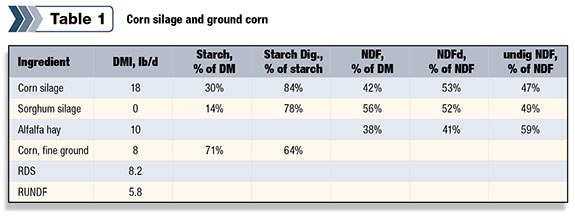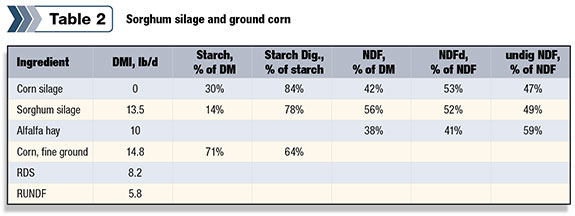As the focus shifts from harvest to planting on most operations, two areas to give consideration to are water and starch availability. Water is a necessity to grow crops, but weather conditions in recent years and water shortages may be driving some dairy producers to consider alternative crops.
And the roller coaster of fluctuating feed prices means that paying close attention to the amount of and availability of starch in feedstuffs becomes increasingly important.
If planting decisions are made based on water availability alone without giving consideration to the amount of starch that will be available in these alternative feedstuffs, milk production could potentially suffer.
As a result, what may look like a good financial move could end up costing the farm more money in the long run. What it boils down to is the less corn silage you have in a feeding program, the more purchased starch you will have to obtain.
Sorghum silage – not the same starch
Sorghum silage is an attractive crop to plant because it can yield approximately the same tonnage per acre and requires less water than corn silage.
The interest in sorghum silage is increasing as a result of recent drought conditions across the U.S. But consideration still needs to be given to the amount of rumen-degradable starch (RDS) that needs to be replaced. Significantly less starch is available from sorghum silage than corn silage.

To evaluate what happens when corn silage is replaced with sorghum silage, let’s look at the forage and carbohydrate portions of two example diets ( Tables 1 and 2 ).
The first example represents a typical corn silage, alfalfa hay and ground corn diet.
It provides 8.2 pounds of RDS and 5.8 pounds of

rumen-undigested neutral-detergent fiber (RUNDF or rumen fill).
The next chart ( Table 2 ) shows what would be required if all of the corn silage was replaced with sorghum silage in order to maintain the same amounts of RDS and rumen fill.
As you can see, the 18 pounds of corn silage was replaced with 13.5 pounds of sorghum silage and 6.8 additional pounds of fine-ground corn.
It took 20.3 pounds of sorghum silage plus supplemental corn (13.5 + 6.8) to replace 18 pounds of corn silage. Therefore, 2.3 pounds of additional formulation space was taken up in the sorghum silage diet.
If you decide to no longer plant corn silage and opt for an alternative such as sorghum silage or use other forages with no starch or low starch, depending upon feed costs, you are potentially looking at the increased cost of purchasing more grain.
Other cropping considerations
When looking at starch and crop selection, other challenges can occur at the other extreme with farms that feed high levels of corn silage.
A farm that crops the majority of its fields as corn silage might feed 75 to 80 pounds of corn silage or 25 to 27 pounds of dry matter from corn silage.
This is not a bad strategy, as the farm won’t likely have to purchase much if any corn because enough starch is available in the corn silage. However, there are still challenges that can arise with this approach.
One of the challenges with this approach is if the corn silage hybrid planted has a very high starch yield – 37 percent starch or more.
A corn silage crop with high starch levels, in a heavy corn silage feeding program, could result in too much RDS fed to the cow, which has potentially negative consequences: milk fat depression, intake depression and production losses.
For example, if you balance the diet right after opening up a freshly harvested bunker, perhaps in November, you might be able to feed 75 to 80 pounds of corn silage, without feeding additional corn, because it provides the right amount of RDS.
However, the rumen degradability of the starch in the corn silage increases over time during ensiled storage.
A few months down the road (June), the same 75 to 80 pounds of corn silage may then provide too much starch because the degradability has increased during storage.
This means, in order for these cows to maintain milk production and milkfat, corn silage will likely need to be pulled out of the diet and replaced with an alternative forage with less starch or lower ruminal starch digestion.
The corn silage is probably going to be replaced with hay because you can’t afford to let rumen NDF levels drop.
Because this example farm did not take starch content and rumen degradability into consideration, it probably won’t be able to feed as high a corn silage diet come June.
This operation will need to plan on feeding alfalfa hay in June because corn silage feeding will need to be reduced.
In this example, if this farm had taken starch availability into consideration at planting, it could have selected a hybrid that had higher tonnage potential but slightly less starch – 30 to 35 percent.
This approach of hybrid selection might also mean that to get the right amount of RDS in November when the bunker was opened, the farm may need to purchase some supplemental corn.
However, by June, one would likely start pulling out most or all of the supplemental corn as ruminal starch digestibility in the corn silage increases.
Selecting the right hybrid
The starch level in a corn hybrid is an important consideration that dairy producers need to consider. If a corn hybrid with high starch content is selected, milkfat depression could be an issue when the summer months roll around.
If a hybrid is selected with too low a starch content, the farm could be facing too little digestible starch in the ration.
It’s a balancing act to select corn hybrids with the right amount of starch and ruminal digestibility.
Monitoring RDS levels in the diet year-round, on an every-other-week basis, can assist dairy producers and nutritionists in determining how much starch is available in the ration, allowing ingredients and milk production to be optimized.
The other component to selecting the right combination of hybrids is NDF digestibility. Work closely with both your agronomist and nutritionist to select the hybrids that can help your operation achieve its production and performance goals. PD
Weakley has a Ph.D. in animal nutrition from Oklahoma State University. He is employed by Forage Genetics International and has more than 30 years of experience in ruminant nutrition. Contact him by email or call him at (636) 742-6178.

David Weakley
Director - Dairy Forage Research
Calibrate Technologies







